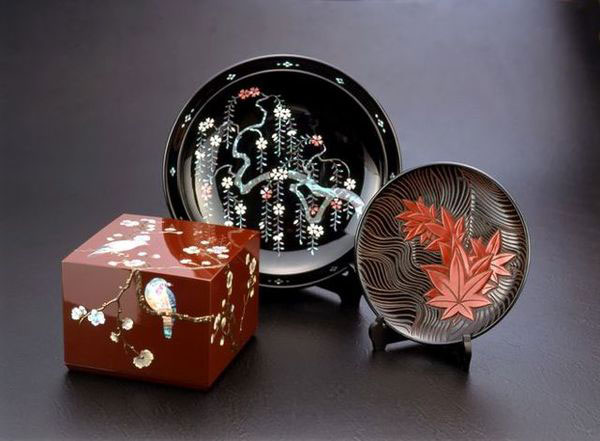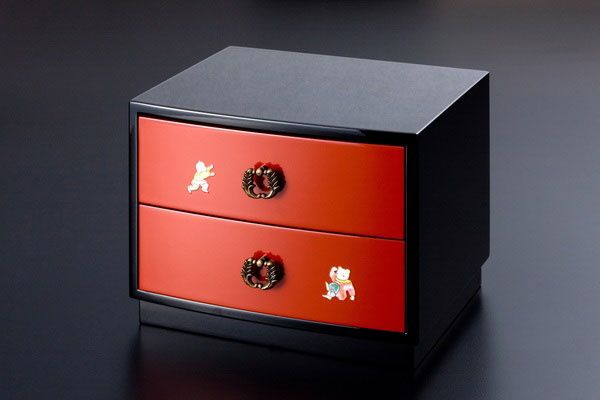
- Lacquerware
- Toyama
Takaoka lacquerware Takaoka shikki
Mysterious and elegant patterns
that depict the beautiful ocean depths
Description
What is Takaoka lacquerware ?
Takaoka lacquerware (called Takaoka shikki in Japanese) is produced in the area around the city of Takaoka, in Toyama prefecture. A defining feature of this lacquerware is the wide range of techniques and styles.
Aogai-nuri is a technique that uses pieces of aogai, thinly-shaved slivers of the shiny parts of seashells, to create triangular and diamond patterns that are then combined to express flowers, birds and natural landscapes. Decorative techniques that use seashells are collectively known as raden. While seashells of approximately 0.3 mm thickness are normally used for raden, seashells of approximately 0.1 mm are often prefered for Takaoka lacquerware. Using thinner seashells allows the color of the base lacquer to show through, giving the seashells a blue glow. The aogai-nuri technique is unique to Takaoka lacquerware.
Another technique is yusuke-nuri, created during the late Edo period (1603-1868) after much research by Yusuke ISHII, who deeply admired Chinese lacquerware from the Ming dynasty (1368-1644). It is a comprehensive technique that involves drawing Chinese-style designs of flowers, birds, natural landscapes and people using rust lacquer. This craft also uses the techniques of aogai, haku-e (gold leaf decorations), applying pebbles, and coating with lacquer.
Lastly, the technique of chokoku-nuri involves coating wood carvings with red or black lacquer. There are designs of plants, animals, peonies, peacocks, and wave crests on raimon (lightning fretwork) or hexagonal patterns, which creates a three-dimensional effect and gives it a unique luster. There are also kawari-nuri pieces that use materials such as plastic and glass.
History

Takaoka lacquerware is said to have started around the year 1609, when Toshinaga MAEDA, the first lord of the Kaga domain (now Toyama prefecture), built the Takaoka Castle and ordered the production of weapons and items for everyday use such as dressers and trays. Takaoka Castle was unfortunately abandoned just five years later, but Takaoka subsequently transitioned to become a commercial and industrial town.
Tsuishu and tsuikoku techniques, which involve engraving designs on a thick base made by coating numerous layers of red or black lacquer, were introduced from China. Those styles created the foundation for the techniques that are used to this day, specifically, chokoku-nuri, raden and rust paintings. Chokoku-nuri was invented based on techniques used by Tanpo TSUJI, who was active between 1764 and 1772. Tsuji's works are also used in the wheeled floats that are paraded during the Takaoka Mikuruma-yama Festival. Tsuji's technique became popular in the early 19th century due to the emergence of master craftsmen such as Koemon ITAYA. In 1850, Yusuke ISHII invented yusuke-nuri after studying Chinese lacquerware from the Ming dynasty, which then grew in popularity during the Meiji period (1868-1912). Recently, kawari-nuri, which involves coating lacquer on various materials, has been garnering attention particularly from the interior design industry.
General Production Process
- 1. Collecting wood
Wood from Japanese zelkova, Japanese horse chestnut, and katsura trees are used for Takaoka lacquerware. The wood is thoroughly dried and cut to produce the wood base of the desired item.
Takaoka lacquerware is mainly produced from the following four types of wood bases. Kuri or carved wood bases are produced by shaving and carving wood using a chisel. A turned wood base is produced by shaving wood that is turned on a lathe. A curved wood base is produced by pasting thin wooden boards together to form ring-shaped bases and a joined wood base is produced by joining several wooden boards.
- 2. Undercoating
Scratches on the wood base are repaired, the surface is smoothened, and fragile parts are strengthened by pasting cloth on the affected parts. The pasting of cloth on fragile parts is known as the nunokise technique. Wood filling powder is then evenly applied to hide the cloth.
- 3. Intermediate coating
Lacquer is applied over the filling powder and left to dry. Once dry, the surface is polished and smoothed. The base preparations are complete at this point.
- 4. Designing for aogai
Shells of abalones, great green turbans, pearl oysters, and box mussels are the materials used for the aogai or Japanese mother-of pearl inlay process. The way aogai will look once the process is complete is considered when designing the lacquerware. This process is important as it requires creativity, keen observation, and expressiveness.
- 5. Cutting shells
The shells are then cut based on the design. Linear parts are cut using blades, smaller parts are pierced using wood carving knives and chisels, while curved lines such as birds and animals are cut out using needles. Precision is especially needed for the process of cutting shells using needles, a technique called harinuki.
- 6. Application of aogai
The designs are transferred to the wood base and a thin layer of adhesive lacquer is applied to parts which the aogai decorations are to be pasted. The cut aogai pieces are then pasted on the lacquered sections of the base.
- 7. Hairline engraving
Once the lacquer has fully dried after pasting the aogai decorations, an extremely fine needle is used to draw details such as human faces and flower cores.
- 8. Minor intermediate coating
Lacquer is coated on the entire wood base, including the aogai portion. Once the lacquer has dried, the lacquer coated on the aogai decorations are peeled with a chisel.
- 9. Overcoating
An overcoat is applied over the entire wood base. Once the lacquer has dried, the entire piece is polished using polishing charcoal from Shizuoka prefecture and roiro charcoal. Finally, a mixture of polishing powder (powder that is produced when cutting whetstones) and canola oil is used to polish the entire piece.
- 10. Rubbing raw lacquer
A very thin layer of raw lacquer is rubbed into the surface. Once the lacquer has dried, the surface is polished by hand using a mixture of canola oil and horn powder (polishing powder produced by powdering baked deer horns) to produce luster. After three to four cycles of the raw lacquer application, drying, and polishing process, the item is finally complete.
Where to Buy & More Information
Takaoka Design Crafts Center
-
Address
-
Tel.+81-766-62-0520
-
ClosedMondays, holidays and around the New Year
-
Business Hours9am to 5pm
-
Website
See more Lacquerware
- Wajima lacquerware
- Kamakura-bori lacquerware
- Tsugaru lacquerware
- Aizu lacquerware
- Yamanaka lacquerware
- Kawatsura lacquerware
- Echizen lacquerware
- Joboji lacquerware
- Kiso lacquerware
- Hidehira lacquerware
- Kagawa lacquerware
- Ryukyu lacquerware
- Takaoka lacquerware
- Wakasa lacquerware
- Hida-shunkei lacquerware
- Ouchi lacquerware
- Kanazawa lacquerware
- Kishu lacquerware
- Kyo laquerware
- Odawara lacquerware
- Naruko lacquerware
- Niigata lacquerware
- Murakami carved lacquerware































































































































































































































































































